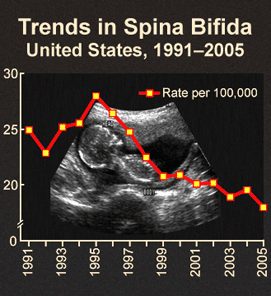Data and Statistics
Each year in the United States
- There are 3,000 pregnancies affected by spina bifida or anencephaly, which are neural tube defects (NTDs) caused by the incomplete closing of the spine and skull.
[Read article] - About 1,300 babies are born without a neural tube defect since folic acid fortification. [Read article]
- Many, but not all, neural tube defects could be prevented if women took 400 mcg of folic acid daily, before and during early pregnancy. [Read article]
- Half of all pregnancies are unplanned. [Read article]

Hispanic/Latina Women
- Have the highest rate among women having a child affected by these birth defects. [Read summary]
- Have lower blood folate levels and are less likely to consume foods fortified with folic acid. [Read article]
- Are less likely to have heard about folic acid, to know it can prevent birth defects, or take vitamins containing folic acid before pregnancy. [Read article]
Use of Supplements Containing Folic Acid Among Women of Childbearing Age — United States
2007 Survey Data

Among all women of childbearing age:
- 40% reported taking folic acid daily.
- 81% reported awareness of folic acid.
- 12% reported knowing that folic acid should be taken before pregnancy.
Women of childbearing age who were aware of folic acid reported hearing about it from:
- Health care provider (33%)
- Magazine or newspaper (31%)
- Radio or television (23%)
- Women aged 18-24 years were more likely to hear about folic acid from a magazine or newspaper (25%) or school or college (22%) than from their health care provider (17%). Whereas 37% of women aged 25-34 years and 36% of women 35-45 years reported hearing about folic acid from their health care provider.
Among women who reported not taking a vitamin or mineral supplement on a daily basis, the most common reasons were:
- “Forgetting” (33%)
- “No need” (18%)
- “No reason” (14%)
- “Already get balanced nutrition” (12%)
2005 Survey Data
Among all women of childbearing age:
- 33% reported taking folic acid daily.
- 84% reported awareness of folic acid.
- 7% reported knowing that folic acid should be taken before pregnancy.
Among women who reported not taking a vitamin or mineral supplement on a daily basis, the most common reasons were:
- Forgetting to take supplements (28%)
- Perceiving they do not need them (16%)
- Believing they get needed nutrients and vitamins from food (9%)
When asked, “For what specific need would you start taking a vitamin or mineral supplement?” The most common reported needs were:
- Being sick or in poor health (20%)
- A doctor’s recommendation (20%)
- The need for energy (9%)
- Being pregnant (8%)
- Being deficient in any vitamins or minerals (7%)
- Balancing the diet (6%)
- Keeping bones strong (6%)
- In addition, 11% cited no specific need that would motivate them to begin taking a vitamin or supplement. Among women who reported not consuming a vitamin or mineral supplement daily, 31% indicated they had received a doctor’s recommendation.
Economic Cost
- The annual medical care and surgical costs for people with spina bifida exceed $200 million. [Read article]
- The total lifetime cost of care for a child born with spina bifida is estimated to be $791,900.1 [Read summary]
Highlighted Articles
Key Findings: Folate Deficiency is Common in Women of Reproductive Age
The Journal of Nutrition has published a study that looks at the amount of folate and vitamin B12 in the blood of non-pregnant women of reproductive age in Belize.
(Published Date: August 18, 2017)
Key Findings: The Promotora de Salud Model Promotes Positive Health Behavior Change
The Journal of Women’s Health has published a new study examining the use of the Promotora de Salud model for folic acid education in Hispanic communities.
(Published Date: January 9, 2017)
Key Findings: Cost savings of spina bifida prevention after folic acid fortification in the United States
Recently, the American Journal of Preventive Medicine published a new study looking at the costs associated with a United States requirement that folic acid (a B vitamin) be added to all cereal grain products labeled as enriched (also called folic acid fortification)
(Published Date: January 11, 2016)
Folic Acid Fortification
Folic acid fortification continues to prevent neural tube defects.
(Published Date: January 2015)
Folic acid use among pregnant women who have had a past pregnancy affected by a neural tube defect
CDC’s Morbidity and Mortality Weekly Report has published a new study looking at folic acid use before pregnancy in women who have had a previous pregnancy affected by a neural tube defect (NTD).
(Published Date: January 2015)
Key Findings: Lack of Vitamins Containing Folic Acid and Diabetes-Associated Birth Defects
Recently, the American Journal of Obstetrics and Gynecology published a CDC study: “Lack of Periconceptional Vitamins or Supplements That Contain Folic Acid and Diabetes Mellitus-Associated Birth Defects”.
(Published Date: December 2014)
Women Need 400 Micrograms of Folic Acid Every Day
The B vitamin folic acid helps prevent birth defects. If a woman has enough folic acid in her body before and while she is pregnant, her baby is less likely to have a major birth defect of the brain or spine.
(Published Date: December 2014)
Plan Ahead: Folic Acid Can Help Prevent Certain Birth Defects
Every woman needs to get enough folic acid each day, even if she does not plan to become pregnant.
(Published: January 11, 2017)
Pop Quiz!
How much do you know about Folic Acid? Take our quiz and find out.
(Published: January 7, 2013)
The Importance of Folic Acid
Read Anifa’s story and find out what CDC is doing to help.
(Published: May 7, 2012)
References
- Grosse SD, Berry RJ, Tilford JM, Kucik JE, Waitzman NJ. Retrospective assessment of cost savings from prevention: Folic acid fortification and spina bifida in the U.S. American Journal of Preventive Medicine. January 2016 [epub ahead of print].
- Page last reviewed: December 14, 2016
- Page last updated: March 30, 2016
- Content source:



 ShareCompartir
ShareCompartir